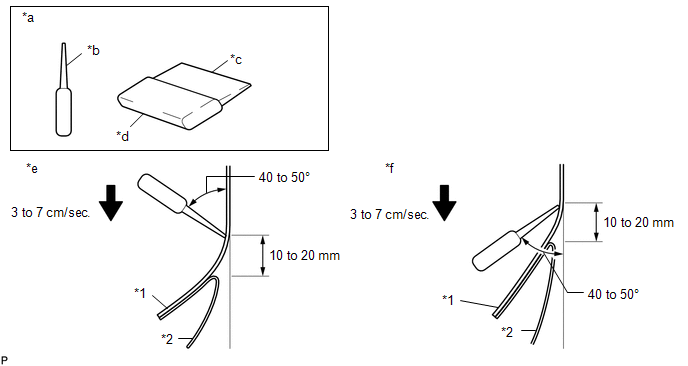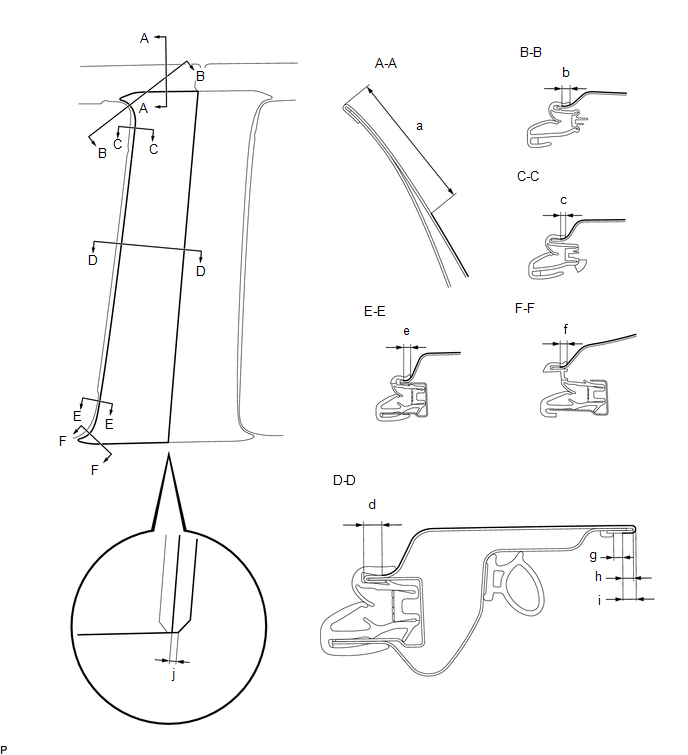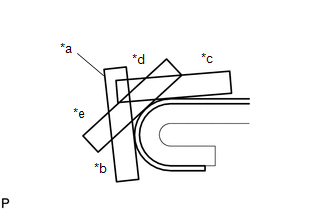Toyota Tacoma (2015-2018) Service Manual: Installation
INSTALLATION
CAUTION / NOTICE / HINT
HINT:
- Use the same procedure for the RH and LH sides.
- The procedure described below is for the LH side.
PROCEDURE
1. REPAIR INSTRUCTION
(a) Clean the vehicle body surface.
(1) Using a heat light, heat the vehicle body surface.
Heating Temperature|
Item |
Temperature |
|---|---|
|
Vehicle Body |
40 to 60ÂḞC (104 to 140ÂḞF) |
NOTICE:
Do not heat the vehicle body excessively.
(2) Clean off any tape adhesive residue with cleaner.
(b) Installation temperature
(1) When the ambient temperature is below 15ÂḞC (59ÂḞF), perform the installation procedure after warming the vehicle body surface (installation surface of the door frame) and tape up to between 20 and 30ÂḞC (68 and 86ÂḞF) using a heat light. When the ambient temperature is above 35ÂḞC (95ÂḞF), cool the vehicle body surface (installation surface of the door frame) and tape down to between 20 and 30ÂḞC (68 and 86ÂḞF) prior to installation.
HINT:
- The most appropriate temperature for installing the tape is 25ÂḞC (77ÂḞF).
- When the temperature is low, the tape becomes stiff and comes off easily. When the temperature is high, the tape elasticity increases.
(c) Before installation
(1) Remove any coating roughness or dirt on and around the vehicle body surface where the tape will be installed (installation surface of the door frame). If any roughness or dirt remains when pressing the tape onto the surface, air will be trapped under the tape and result in a poor appearance.
HINT:
Spray water on the shop floor to settle any dust.
(d) Key points for handling the tape
(1) The tape bends and rolls up easily. Store the tape between flat pieces of cardboard or other similar objects and keep it dry and flat.
NOTICE:
Do not bend the tape or leave it in high temperature places.
(e) Key points for installation of the tape (how to use a squeegee and installation procedure for flat surfaces)
NOTICE:
- Position the tape accurately to achieve a neat finish and to avoid peeling.
- The tape cannot be reused because it deforms after removal.
(1) To avoid air bubbles, slightly raise the part of the tape that is going to be applied so that its adhesive surface does not touch the vehicle body prematurely. Tilt the squeegee at 40 to 50ÂḞ (pressing forward) or 30 to 45ÂḞ (pulling) to the vehicle body surface and press the tape onto the vehicle body surface with a force of 20 to 30 N (2 to 3 kgf, 4.5 to 6.7 lbf) at a constant slow speed of 30 to 70 mm (1.18 to 2.76 in.) per second.
 Text in Illustration
Text in Illustration
|
*1 |
Black Out Tape |
*2 |
Release Paper |
|
*a |
Sectional View |
*b |
Squeegee |
|
*c |
Non-padded Side |
*d |
Padded Side |
|
*e |
Pressing |
*f |
Pulling |
NOTICE:
Be sure to observe the specified pressing speed, force and angle of the squeegee to avoid wrinkles or air bubbles.
HINT:
- Either angle of the squeegee (pressing forward or pulling) is acceptable.
- Be sure to apply the tape while removing the release paper 10 to 20 mm (0.394 to 0.787 in.) from the edge of the squeegee.
(f) Key points for installation of the tape (how to use a squeegee and installation procedure for hemmed surfaces)
|
(1) If it is difficult to apply the tape, install it in several steps as shown in the illustration. Use your fingers or the padded surface of a squeegee to slowly apply the tape to the hem of the vehicle, especially for a small hem. Text in Illustration
HINT: When applying tape to the backside of a hem, remove the release paper and use your fingers or the padded surface of a squeegee. |
|
(g) Key points for installation of the tape (how to use a squeegee and installation procedure for corners)
(1) Remove the release paper and apply the tape carefully with your fingers.
(2) Before applying the tape to each corner, heat the tape using a heat light and gradually apply it, avoiding wrinkles on the tape to achieve a neat finish.
(h) Check after installation
(1) After completing the application, check if the tape is applied neatly. If the tape is not applied neatly, reapply using new tape.
NOTICE:
Do not reuse the tape.
2. INSTALL NO. 1 BLACK OUT TAPE
(a) Refer to the illustration to position a new No. 1 black out tape.
 Standard Measurement
Standard Measurement
|
Dimension |
Measurement |
Dimension |
Measurement |
|---|---|---|---|
|
a |
41.8 mm (1.646 in.) |
b |
5.5 mm (0.217 in.) |
|
c |
3.7 mm (0.146 in.) |
d |
5.7 to 5.9 mm (0.224 to 0.232 in.) |
|
e |
4.6 mm (0.181 in.) |
f |
4.1 mm (0.161 in.) |
|
g |
Below 1 mm (0.0394 in.) |
h |
2.0 to 4.0 mm (0.0787 to 0.157 in.) |
|
i |
3.1 to 5.1 mm (0.122 to 0.200 in.) |
j |
2.0 mm (0.0787 in.) |
Remove the release paper and apply the No. 1 black out tape.
3. INSTALL FRONT DOOR GLASS OUTER WEATHERSTRIP ASSEMBLY
(See page .gif)
.gif) )
)
4. INSTALL FRONT DOOR GLASS RUN
.gif)
.gif)
.gif)
 Components
Components
COMPONENTS
ILLUSTRATION
...
 Removal
Removal
REMOVAL
CAUTION / NOTICE / HINT
HINT:
Use the same procedure for the RH and LH sides.
The procedure described below is for the LH side.
PROCEDURE
1. REMOVE FRONT DOOR GLASS RUN
...
Other materials:
Reassembly
REASSEMBLY
PROCEDURE
1. INSTALL RADIATOR GRILLE MOULDING
(a) Engage the 8 claws to install the radiator grille moulding.
(b) Install the 8 screws.
2. INSTALL NO. 1 RADIATOR GRILLE GARNISH
(a) for Type A and Type B:
(1) Engag ...
System Description
SYSTEM DESCRIPTION
1. POWER DOOR LOCK CONTROL SYSTEM DESCRIPTION
(a) The power door lock system locks/unlocks all the doors.
The main body ECU (multiplex network body ECU) receives lock/unlock request signals
from a door control switch or the driver door key lock and unlock switch. Then,
the ...
Dtc Check / Clear
DTC CHECK / CLEAR
1. CHECK FOR DTC
HINT:
When using the Techstream with the engine switch off to troubleshoot:
Connect the Techstream to the DLC3 and turn a courtesy light switch on and off
at 1.5-second intervals until communication between the Techstream and vehicle begins.
(a) Connect the ...

